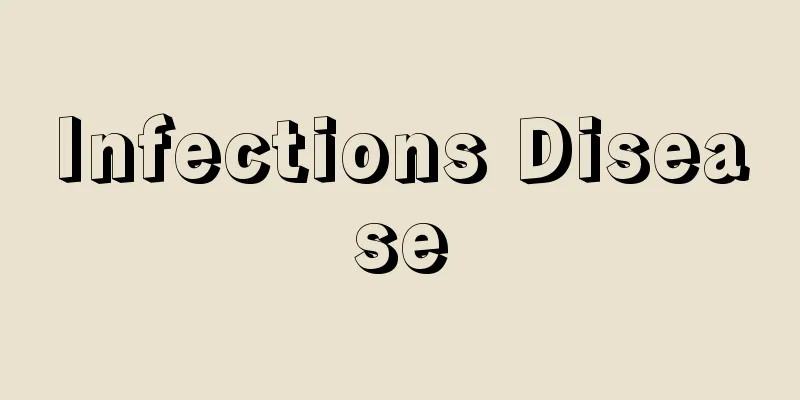Infections Disease

|
Infectious diseases are caused by microorganisms that enter the body and multiply there. Many infectious diseases are contagious, so it is important to take care not to spread them to others. Infection and onset of the disease Carriers Infectious and contagious diseases What is immunity? Source and route of infection ● Droplet infection (respiratory tract infection) Oral infection ● Sexually transmitted infection (contact infection) Percutaneous infection Insect vectors Infection resulting from medical procedures Opportunistic infection (Hiyori mikansen) Nosocomial infection ● Cross-infection ●Autoinfection (endogenous infection) Vertical infection and mother-to-child infection Horizontal infection Infection and onset of the disease Microorganisms that cause disease are called pathogenic microorganisms, and in order of size, they include viruses, bacteria (mycoplasma, chlamydia, rickettsia, spirochetes, general bacteria), protozoa, parasites, etc. When these pathogenic microorganisms invade the body and reproduce in organs and tissues, it is called an infection. When a person is infected with a pathogenic microorganism, they may or may not develop an illness. For example, if Shigella bacteria mixed in food or drink is swallowed and multiplies in the intestines, it can cause fever and diarrhea, but if the degree of multiplication is small, symptoms that seem like illness may not appear. The former is called an apparent infection (disease), and the latter is called an asymptomatic infection. ● Carrier (Bacterial carrier) Pathogenic microorganisms can take up residence in the body in an asymptomatic state. This is often seen in cases of hepatitis B and AIDS. In this way, people who have pathogenic microorganisms in their bodies are called carriers, and there is a risk that they will infect people around them with the pathogenic microorganisms, and that the pathogenic microorganisms in the body may multiply and cause illness in the future. Infectious diseases and contagious diseases There are two types of infectious diseases: infectious diseases that are transmitted from person to person, such as influenza and dysentery, and non-communicable diseases that are not transmitted from person to person, such as cystitis and tetanus. Of these, infectious diseases are usually simply called infectious diseases. In addition, infectious diseases caused by more advanced organisms, such as malaria and ascariasis, are called parasitic diseases and are treated separately. ●Immunity People who have recovered from measles, mumps, rubella, etc. will not get the disease again. This is because antibodies are produced in the body, which suppress the proliferation of the same pathogenic microorganisms even if they invade again. This function of the body is called immunity. The period of time immunity lasts varies depending on the disease. Measles, mumps, rubella, etc. provide immunity that lasts a lifetime. This is called lifelong immunity. Influenza, diphtheria, etc., only provide short-term immunity. Since the body does not develop immunity to diseases such as tonsillitis caused by staphylococcus or streptococcus, it is possible to contract the same disease multiple times. ●Sources of infection and routes of infection Sources of infection, such as sick people, carriers, infected animals, vector insects, excrement contaminated with pathogenic microorganisms, and objects contaminated by them, are called sources of infection. The route by which pathogenic microorganisms enter the human body from the source of infection is called the route of infection. There are several different routes of infection, and they vary depending on the pathogenic microorganism. ● Droplet infection (respiratory tract infection) Influenza viruses are contained in droplets (tiny, invisible droplets) that people with influenza expel from their mouths when coughing or talking. Influenza spreads from person to person when people around inhale these droplets. This type of infection is called droplet infection, and it is the infection route used by tonsillitis, measles, rubella, strep throat (scarlet fever), herpangina, and hand, foot, and mouth disease. Oral infection Oral infection is when pathogenic microorganisms or parasitic eggs enter the body through the mouth. Cholera, typhoid fever, dysentery, Vibrio parahaemolyticus food poisoning, Campylobacter food poisoning, Salmonella food poisoning, roundworm disease, and pinworm disease are all caused by pathogenic microorganisms or parasitic eggs that are mixed in food or drink or on the hands. Sexual transmission (contact transmission) Sexually transmitted infections occur when pathogenic microorganisms present in lesions of the skin or mucous membranes or in bodily fluids are transmitted from person to person during sexual intercourse. Examples of infections that occur through this route include gonococcal urethritis, syphilis, vaginal candidiasis, vaginal trichomoniasis, genital herpes, AIDS, and hepatitis B. Percutaneous infection Percutaneous infection occurs when pathogenic microorganisms enter through the skin. The pathogens that cause Weil's disease, Lestospira japonicum, and Schistosoma japonicum, can enter and infect even through healthy skin, while tetanus bacteria and the rabies virus enter through wounds in the skin. ●Transmission by insects Malaria and Japanese encephalitis are transmitted by mosquitoes, plague by fleas, typhus by lice, and scrub typhus by ticks. ●Infections caused by medical proceduresThis includes cystitis associated with catheterization, infection with hepatitis B or syphilis through blood transfusions from sick people, especially those who have no symptoms, and infection with AIDS through unsterilized syringes. Opportunistic infection (Hiyori mikansen) Various microorganisms, known as resident flora, constantly attach to or reside inside our bodies (in the nasal cavity, oral cavity, large intestine, vagina, etc.) and on the surface of our skin. There are also countless microorganisms around us. However, when we are healthy, our body has the ability to resist these microorganisms and we do not get sick. When the body's resistance decreases, these microorganisms can multiply abnormally and make us sick. This is known as an opportunistic infection. Causes of opportunistic infections include: 1) weakness due to cancer, 2) diseases that reduce the body's resistance, such as AIDS, severe diabetes, kidney failure, liver failure, and cerebrovascular disorders, 3) weakened immunity due to the use of medications (anticancer drugs, immunosuppressants, adrenal cortical hormone drugs, etc.), 4) bacterial replacement due to the continuous use of broad-spectrum antibiotics, 5) bone marrow damage due to side effects of radiation therapy, and 6) advanced age. Diseases caused by opportunistic infections include Pseudomonas aeruginosa infections (column "Pseudomonas aeruginosa infections"), fungal infections ("What are skin mycoses?"), and MRSA (multidrug-resistant Staphylococcus aureus) infections. Nosocomial infection Infections that occur within a hospital are called nosocomial infections. In addition to cases such as a child hospitalized with kidney disease contracting measles, or a person with difficulty urinating who is using a catheter to catch cystitis, nosocomial infections can also occur when visitors or hospital staff contract an infectious disease within the hospital. There are two ways infections can occur: ● Cross-infection This is a case where a pathogenic microorganism is transmitted from a sick person to other people directly or indirectly (through equipment, etc.). For example, a child in the early stages of measles is hospitalized for an illness such as fever of unknown cause, without knowing that it is measles, and other hospitalized children contract measles, or a school lunch staff member is a carrier of Salmonella bacteria, causing a mass outbreak of Salmonella food poisoning among hospitalized sick people. Another example of cross-infection is when a nurse accidentally pricks her finger with a needle used to draw blood from a patient with Hepatitis B and contracts Hepatitis B. ●Autoinfection (endogenous infection) Autoinfection occurs when bacteria that normally reside on the skin, mouth, nasal cavity, intestinal tract, vagina, etc., infect and cause illness. Normal bacteria do not cause illness as long as they are present in the areas where they normally reside, but if they move to other areas, they may cause illness. For example, many cases of cystitis in women are autoinfection caused by Escherichia coli, a normal inhabitant of the large intestine. However, there are also cases of female cystitis caused by infection with bacteria in the hospital via catheterization equipment. In this case, cross-infection occurs. Vertical infection and mother-to-child infection Pathogenic microorganisms such as syphilis and hepatitis B present in the mother's body can infect the fetus through the placenta. In addition, pathogenic microorganisms such as chlamydia and gonorrhea present in the mother's birth canal can infect the baby during childbirth and cause conjunctivitis. This type of infection that occurs vertically, from mother to child, is called vertical infection, and is also a type of cross-infection in a broad sense. In addition, during breastfeeding and other close contact between mother and child, pathogenic microorganisms that the mother has can be transmitted to the baby. Such infections are also called maternal-fetal infections. Horizontal infection Vertical infection is when an infectious disease is transmitted vertically from mother to child, whereas horizontal infection (cross infection), such as influenza, is when the infection spreads horizontally to an unspecified number of people in the vicinity. Source: Shogakukan Home Medical Library Information |
|
微生物が体内に侵入し、そこで繁殖(はんしょく)したためにおこる病気を感染症といいます。感染症の多くは伝染する危険があるので、周囲の人にうつさない配慮が必要です。 ●感染と発病 ●キャリア(保菌者) ●感染症と伝染病 ●免疫(めんえき)とは ●感染源と感染経路 ●飛沫感染(ひまつかんせん)(経気道感染(けいきどうかんせん)) ●経口感染(けいこうかんせん) ●性行為感染(接触感染) ●経皮感染(けいひかんせん) ●昆虫による媒介 ●医療的行為に起因する感染 ●日和見感染(ひよりみかんせん) ●院内感染(いんないかんせん) ●交差感染(こうさかんせん) ●自己感染(内因感染) ●垂直感染(すいちょくかんせん)と母子間感染(ぼしかんかんせん) ●水平感染 ●感染(かんせん)と発病(はつびょう) 病気をおこす微生物を病原微生物といい、小さい順にウイルス、細菌(マイコプラズマ、クラミジア、リケッチア、スピロヘータ、一般細菌)、原虫、寄生虫(きせいちゅう)などがあります。これらの病原微生物が体内に侵入し、臓器や組織の中で繁殖することを感染といいます。 病原微生物が感染すると、発病する場合と、発病しない場合とがあります。たとえば、飲食物にまじっていた赤痢菌(せきりきん)が飲み込まれ、腸管内で繁殖すると、発熱や下痢(げり)がおこりますが、繁殖の程度がわずかな場合は、病気らしい症状が現われないこともあります。前者を顕性感染(けんせいかんせん)(発病)といい、後者を不顕性感染といいます。 ●キャリア(保菌者(ほきんしゃ)) 病原微生物が、不顕性感染の状態で体内にすみつくこともあります。B型肝炎やエイズなどでしばしばみられます。このように、病原微生物を体内にもっている人をキャリアといい、周囲の人に病原微生物を感染させる危険がありますし、体内の病原微生物が繁殖して、将来、発病する恐れもあります。 ●感染症(かんせんしょう)と伝染病(でんせんびょう) 感染症には、インフルエンザや赤痢のように人から人へと伝染する伝染性感染症と、膀胱炎(ぼうこうえん)や破傷風(はしょうふう)のように人から人へは伝染しない非伝染性感染症とがあります。このうち、伝染性感染症はふつう、単に伝染病といいます。 なお、マラリアや回虫症(かいちゅうしょう)のように、かなり高等な生物による感染症は寄生虫病といい、別に扱われます。 ●免疫(めんえき)とは はしか、おたふくかぜ、風疹(ふうしん)などにかかって治った人は、再びその病気になることはありません。からだの中に抗体(こうたい)というものができていて、再び同じ病原微生物が侵入してきても、繁殖させないように抑えるからです。 このからだのはたらきを免疫といいます。病気によって、免疫の続く期間が異なります。はしか、おたふくかぜ、風疹などは一生続く免疫ができます。これを終生免疫(しゅうせいめんえき)といいます。 インフルエンザ、ジフテリアなどは、短期間の免疫しかできません。 ブドウ球菌(きゅうきん)、レンサ球菌による扁桃炎(へんとうえん)などでは免疫ができないので、同じ病気に何度もかかる可能性があります。 ●感染源(かんせんげん)と感染経路 感染の源になるもの、つまり、病人、キャリア、感染動物、媒介(ばいかい)する昆虫、病原微生物で汚染された排泄物(はいせつぶつ)や、それによって汚染されたものなどを感染源といいます。 病原微生物が、感染源から人体に侵入する道筋を感染経路といい、つぎのようなものがあって、病原微生物によって感染経路がちがいます。 ●飛沫感染(ひまつかんせん)(経気道感染(けいきどうかんせん)) インフルエンザにかかった人が、せきや会話の際に口から飛ばす飛沫(目に見えない細かい水滴=しぶき)の中には、インフルエンザウイルスが含まれています。この飛沫を周囲の人が吸い込むことによって、インフルエンザは人から人へと伝染します。このような感染経路を飛沫感染といい、扁桃炎、はしか、風疹、溶連菌感染症(ようれんきんかんせんしょう)(猩紅熱)、ヘルパンギーナ、手足口(てあしくち)病などがこの感染経路をとります。 ●経口感染(けいこうかんせん) 病原微生物や寄生虫の卵が、口から入って感染するのを経口感染といいます。コレラ、腸チフス、赤痢(せきり)、腸炎ビブリオ食中毒、カンピロバクター食中毒、サルモネラ食中毒、回虫症、蟯虫(ぎょうちゅう)症などは、飲食物にまじったり手指についたりした病原微生物や寄生虫の卵が口から入って感染します。 ●性行為感染(せいこういかんせん)(接触感染) 性行為の際に、皮膚や粘膜(ねんまく)の病変部、体液の中にいる病原微生物が人から人へと感染するのが性行為感染です。淋菌性尿道炎(りんきんせいにょうどうえん)、梅毒(ばいどく)、腟(ちつ)カンジダ症、腟トリコモナス症、性器ヘルペス、エイズ、B型肝炎などがこの感染経路をとります。 ●経皮感染(けいひかんせん) 病原微生物が、皮膚から侵入して感染するのが経皮感染で、ワイル病の病原菌のレストスピラや日本住血吸虫(にほんじゅうけつきゅうちゅう)は、健康な皮膚からでも侵入して感染しますが、破傷風菌や狂犬病ウイルスは、皮膚の傷口から侵入して感染します。 ●昆虫による媒介 マラリアや日本脳炎は、カに媒介されて、ペストはノミに、発疹(ほっしん)チフスはシラミに、つつがむし病はダニに媒介されて感染します。 ●医療的行為に起因する感染 導尿(どうにょう)に関連しておこった膀胱炎(ぼうこうえん)、病人、とくに自覚症状のない病人の血液の輸血によるB型肝炎や梅毒の感染、消毒していない注射器によるエイズの感染などをいいます。 ●日和見感染(ひよりみかんせん) 私たちの体内(鼻腔(びくう)、口腔(こうくう)、大腸(だいちょう)、腟など)や皮膚の表面には、常在菌(じょうざいきん)といって、いろいろな微生物が常に付着したり、すみついたりしています。また、私たちの周囲にも無数の微生物が存在しています。しかし、健康なときには、これらの微生物に対する抵抗力がからだに備わっているので病気になることはありません。からだの抵抗力が低下すると、これらの微生物が異常に繁殖し、病気になることがあります。これを日和見感染といいます。 日和見感染をおこす原因には、①がんなどによる衰弱(すいじゃく)、②エイズ、重症糖尿病、腎不全(じんふぜん)、肝不全、脳血管障害などのからだの抵抗力が低下する病気、③薬剤(抗がん剤、免疫抑制薬、副腎皮質(ふくじんひしつ)ホルモン薬など)使用による免疫力の低下、④広域抗生物質の連用による菌交代現象、⑤放射線療法の副反応による骨髄(こつずい)障害、⑥高年齢、などがあります。 日和見感染によっておこる病気としては、緑膿菌感染症(コラム「緑膿菌感染症」)、真菌症(しんきんしょう)(「皮膚真菌症とは」)、MRSA(多剤耐性(たざいたいせい)ブドウ球菌)感染症などがあります。 ●院内感染(いんないかんせん) 病院内でおこる感染を院内感染といいます。腎臓病で入院中の子どもがはしかにかかる、排尿困難で導尿している人が膀胱炎にかかるなどのほか、見舞いに訪れた人や病院職員なども病院内で感染症にかかれば院内感染です。感染のしかたには、つぎの2つがあります。 ●交差感染(こうさかんせん) 病原微生物が、病人から直接に、または間接に(器物を介してなど)他の人に感染するケースです。たとえば、はしかの発病初期の子どもが、はしかとはわからず原因不明の発熱などの病名で入院したため、入院中のほかの子にはしかが発生するとか、給食課の職員にサルモネラ菌の保菌者がいたため、入院している病人にサルモネラ食中毒が集団発生する、などがその代表です。また、B型肝炎の病人から採血した注射針を誤って自分の指に刺してしまい、看護師がB型肝炎にかかるのも交差感染です。 ●自己感染(内因感染) 自分の皮膚、口腔、鼻腔、腸管、腟などにいる常在菌が感染して病気がおこるのが自己感染です。常在菌は、常在している部位にいるかぎり病気をおこすことはありませんが、ほかの部位に移動すると病気がおこることがあるのです。 たとえば女性の膀胱炎の多くは、自分の大腸の常在菌である大腸菌が感染したための自己感染です。 しかし、導尿の際に、器具を介して病院内の細菌が感染しておこる女性の膀胱炎もあります。この場合は、交差感染ということになります。 ●垂直感染(すいちょくかんせん)と母子間感染(ぼしかんかんせん) 母親の体内にいる梅毒やB型肝炎などの病原微生物が、胎盤(たいばん)を介して胎児(たいじ)に感染してしまうことがあります。 また、母親の産道(さんどう)にいるクラミジアや淋菌(りんきん)などの病原微生物が、出産の際に赤ちゃんに感染して結膜炎(けつまくえん)をおこすことがあります。 このように、母から子へという縦の関係で感染するのを垂直感染といいますが、これも、広い意味での交差感染の一種です。 また、育児中の母と子は、授乳その他の濃厚な接触によって、母親のもっている病原微生物が赤ちゃんに感染することもあります。このような感染を含めて母子間感染ともいいます。 ●水平感染(すいへいかんせん) 感染症が、母から子へと縦に感染するのを垂直感染というのに対して、インフルエンザのように、周囲の不特定多数の人々へ横に広がる感染(交差感染)を水平感染といいます。 出典 小学館家庭医学館について 情報 |
Recommend
Parenting ghost - Kosodate Yuurei
This is a folktale about a pregnant woman who dies...
Fire enema cloth
It is a non-flammable cloth woven from asbestos t...
Red-eared dragon - Red-eared dragon
...Briar pipes are made from the roots of E. arbo...
Republic of Natal - Natal Kyowakoku (English spelling) Republic of Natal
A country established by the Boers on the Indian O...
Dracaena reflexa (English spelling)
… [Takabayashi Masatoshi]. … *Some of the termino...
Kataib - Kataib
...As Muslim dissatisfaction and criticism of thi...
Tātā, JN (English spelling) TataJN
…Along with the Birla conglomerate, it is one of ...
Cart (car) - car
…In 1956, an American racing car designer created...
Ablation method
...On the other hand, the speed at which a spacec...
Basking shark
…It is called Baka-zame (baka shark) because it l...
Conversations-lexikon (English)
…Furtier's dictionary is known to have been c...
dandy
...Generally, it means a man's "perfect ...
Shipowners' Mutual Protection and Indemnity Association (Senshusekininsougohokenkumiai)
A mutual insurance association formed by shipowner...
Hakodate [city] - Hakodate
A city in southwest Hokkaido. Established as a cit...
Fegefeuer
…The Latin word purgatorium comes from purgare (m...









